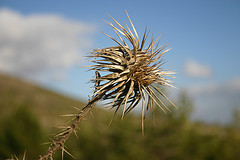|
밀크티슬(Milk Thistle)
밀크티슬의 주요성분인 실리마린은 일종의 플라보노이드의 구룹입니다, 이 실리마린이 알콜이나 다른 독성물질에 의하여 손상된 간세포를 재생시키는 것을 도와 준다고 믿고 있습니다. 또한 새로운 세포가 이러한 독 물질로 손상되는 것으로 막고 염증을 개선시킨다고 여겨집니다. 실리마린 그 자체는 대단히 강력한 항산화제입니다 알콜성 간질환과 밀크티슬 - 밀크티슬이 알콜성 간염, 알콜성 간경화 치료 바이러스 성 간염 - 간염 (특히 C형 간염)에 밀크티슬이 이용되어서 많은 경우에 간 기능이 향상 암과 밀크티슬 - 밀크티슬의 주요성분인 실리마린과 다른 성분들이 항암효과를 가지고 있는 것으로 연구에서 확인. 암세표가 분열되어 증가되는 것을 예방하고 암세포의 수명을 줄이며 암세포로의 혈액공급을 차단하여 크기를 줄이기도 합니다. 밀크티슬은 독 버섯 해독에 이용됩니다 -동물실험으로 독버섯을 먹은 후 10분내로 밀크티슬을 복용하면 완전해독 되는 것으로 발펴졌습니다. 24시간내로 밀크티슬을 먹으면 간장손상과 사망을 예방할 수 있습니다. 이것은 밀크티슬의 해독작용의 한 단면을 보여주는 것입니다. 같이 복용해서는 안되는 약들 종류
같이 복용할 경우 흡수가 방해가 되는 약 종류 (밀크티슬을 복용하기 전 의사와 상의하세요)
(원문) 미국 메일랜드 대학 의과대학자료 출처 : http://www.umm.edu/altmed/articles/milk-thistle-000266.htm Milk thistle (Silybum marianum) has been used for 2,000 years as an herbal remedy for a variety of ailments, particularly liver problems. Several scientific studies suggest that substances in milk thistle (especially a flavonoid called silymarin) protects the liver from toxins, including certain drugs such as acetaminophen (Tylenol), which can cause liver damage in high doses. Silymarin has antioxidant and anti-inflammatory properties, and it may help the liver repair itself by growing new cells. Although a number of animal studies demonstrate that milk thistle can be helpful in protecting the liver, results in human studies are mixed. Mushroom Poisoning Milk thistle has been used as an emergency antidote to poisoning by deathcap mushroom (Amanita phalloides). Animal studies have found that milk thistle extract completely counteracts the toxic effects of the mushroom when given within 10 minutes of ingestion. If given within 24 hours of ingestion, it significantly reduces the risk of liver damage and death. Liver disease from alcohol Although milk thistle is often suggested as a treatment for alcoholic hepatitis and alcoholic cirrhosis, scientific studies show mixed results. Some studies show improvements in liver function and survival rate. But problems in the design of the studies (such as small numbers of participants and differences in dosing and duration of milk thistle therapy) make it difficult to draw any real conclusions. Viral hepatitis Although milk thistle is widely used in the treatment of viral hepatitis (particularly hepatitis C), results from four studies were contradictory. Some found improvements in liver function, while others did not. None of the studies compared milk thistle with interferon or other medications for viral hepatitis. Cancer Early laboratory studies also suggest that silymarin and other active substances in milk thistle may have anti-cancer effects. These substances appear to stop cancer cells from dividing and proliferating, shorten their life span, and reduce blood supple to tumors. More studies are needed, however, to show whether milk thistle has any effects in the body (not just test tubes). Plant Description:Milk thistle is native to the Mediterranean region, and is now found throughout the world. This stout thistle usually grows in dry, sunny areas. The spiny stems branch at the top, and reach a height of 4 to 10 feet. The leaves are wide, with white blotches or veins. Milk thistle gets its name from the milky white fluid that comes from the leaves when they are crushed. The flowers are red-purple. The small, hard-skinned fruit is brown, spotted, and shiny. Milk thistle spreads quickly (it is considered a weed in some parts of the world), and it matures quickly, in less than a year. What's It Made Of?:The active ingredient, or liver-protecting compound, in milk thistle is known as silymarin. Silymarin is actually a group of flavonoids (silibinin, silidianin, and silicristin), which are thought to help repair liver cells damaged by alcohol and other toxic substances. Silymarin also keeps new liver cells from being destroyed by these same substances, reduces inflammation (which is why it is often suggested for people with liver inflammation or hepatitis), and is a potent antioxidant. Most milk thistle products are standardized preparations made from the seeds of the plant. Most preparations are standardized to contain 70 - 80% of silymarin. Available Forms:
A few studies show that a silymarin-phosphatidylcholine complex may be absorbed more easily than regular standardized milk thistle. A key element in cell membranes, phosphatidylcholine helps silymarin attach easily to cell membranes. This may keep toxins from getting inside liver cells. Alcohol extracts should be avoided by anyone with alcohol-related liver disease. How to Take It:Pediatric There are no studies showing whether it is safe to give milk thistle to a child. Liver problems can be serious and should be diagnosed by a physician. Talk to your doctor before giving milk thistle to a child. Adult If you think you have a liver problem, you should see a doctor, as liver disease can be life-threatening.
Precautions:The use of herbs is a time-honored approach to strengthening the body and treating disease. Herbs, however, can trigger side effects and can interact with other herbs, supplements, or medications. For these reasons, herbs should be taken with care, under the supervision of a health care practitioner. Side effects are usually mild and may involve stomach upset and diarrhea. Some people may get a rash from touching milk thistle plants. Milk thistle should not be used by pregnant or breastfeeding women. People with a history of hormone-related cancers, including breast and uterine cancer and prostate cancer, should not take milk thistle. Possible Interactions: (상호작용이 가능한 약)If you are currently being treated with any of the following medications, you should not use milk thistle without first talking to your healthcare provider.
Milk thistle may interfere with the following medications, because both milk thistle and these medications are broken down by the same liver enzymes:
|
밀크티슬 (실리마린) 과 간장 건강
by hsk posted Oct 18, 2009
?
Larger Font
Smaller Font
Up
Down
Go comment
Print Shortcut
PrevPrev Article
NextNext Article
ESCClose

 간 추출물 (Liver Extract)과 간질환 개선 - 요약 번역
간 추출물 (Liver Extract)과 간질환 개선 - 요약 번역


